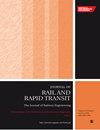Force transmission and height adjustment stability of the new height adjustable long pillow ballastless track
IF 2.1
4区 工程技术
Q3 ENGINEERING, CIVIL
Proceedings of the Institution of Mechanical Engineers Part F-Journal of Rail and Rapid Transit
Pub Date : 2024-03-28
DOI:10.1177/09544097241241418
引用次数: 0
Abstract
To address the settlement issue in high-speed railway foundations, the present study introduces a novel ballastless track system called NHABT (New height-adjustable ballastless track). This paper outlines the structural characteristics of the track and provides a detailed explanation of the methodology employed for height adjustment. To account for the unique properties of the NHABT structure, this study establishes finite element and vehicle-track coupling dynamics models. Firstly, under wheel load conditions, the study investigates the stress distribution of the NHABT structure and analyzes the influence of track bed length, thickness, and height adjustment on the force transfer characteristics of the NHABT structure. Secondly, the impact of height adjustment on the quality of vehicle operation and the stability of the NHABT structure is examined. The results indicate that adjusting the NHABT structure within a range of 20 to 200 mm is achievable by changing the side support pad or sleeper. The maximum stress occurs in the folded corner area on both sides of the sleeper groove. The force transfer characteristics of the NHABT structure are not affected by the length of the track bed, but its thickness significantly influences the stress in the folding corner area of the sleeper groove. The vehicle running quality and the stability of the NHABT structure after the adjustment are maintained at the same level as before the adjustment.新型高度可调长枕式无砟轨道的力传递和高度调节稳定性
为解决高速铁路地基的沉降问题,本研究引入了一种新型无砟轨道系统,即 NHABT(新型高度可调式无砟轨道)。本文概述了该轨道的结构特点,并详细解释了高度调整所采用的方法。为了解释 NHABT 结构的独特特性,本研究建立了有限元模型和车辆-轨道耦合动力学模型。首先,在车轮载荷条件下,研究了 NHABT 结构的应力分布,并分析了轨枕长度、厚度和高度调整对 NHABT 结构力传递特性的影响。其次,研究了高度调整对车辆运行质量和 NHABT 结构稳定性的影响。结果表明,通过改变侧支撑垫或枕木,可以在 20 至 200 毫米的范围内调整 NHABT 结构。最大应力出现在枕木槽两侧的折角区域。NHABT 结构的力传递特性不受轨枕长度的影响,但其厚度对轨枕槽折角区域的应力有很大影响。调整后的车辆行驶质量和 NHABT 结构的稳定性与调整前保持一致。
本文章由计算机程序翻译,如有差异,请以英文原文为准。
求助全文
约1分钟内获得全文
求助全文
来源期刊

CiteScore
4.80
自引率
10.00%
发文量
91
审稿时长
7 months
期刊介绍:
The Journal of Rail and Rapid Transit is devoted to engineering in its widest interpretation applicable to rail and rapid transit. The Journal aims to promote sharing of technical knowledge, ideas and experience between engineers and researchers working in the railway field.
 求助内容:
求助内容: 应助结果提醒方式:
应助结果提醒方式:


